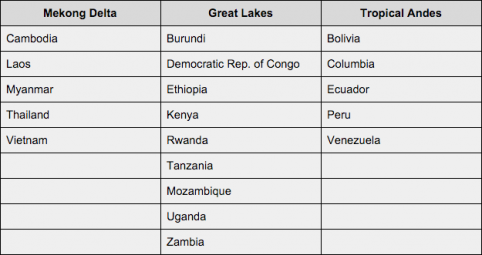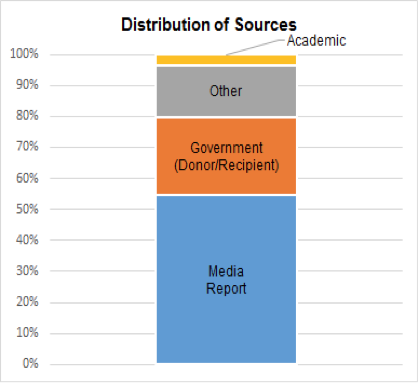China’s economic growth depends on its ability to secure natural resources. Many are found in environmentally-sensitive areas, which are rich in biodiversity, vulnerable populations, and sources of freshwater - and Chinese development projects. China is using these projects as a way to secure access to the resources it needs. But, what lies in the wake of these massive dams and large-scale infrastructure projects? How do they affect the surrounding region?
AidData is looking to answer these questions by teaming up with the MacArthur Foundation to analyze the impact of Chinese development finance on biological conservation in the Tropical Andes, Mekong Delta, and the Great Lakes.
The ambitious three-phase project includes data collection, geocoding, and a geospatial impact evaluation of Chinese activity in these regions between 2000-2014. With the first phase complete, we thought this would be an opportune time to reflect on what we learned during the data collection process. We are excited to announce that our completed dataset will soon be geocoded and available on china.aiddata.org in June 2016, moving our TUFF project beyond Africa and into Asia and Latin America - and eventually, the rest of the world.
An Overview of the Data
The forthcoming dataset captures more than 1100 Chinese projects from 2000 to 2014 in 19 countries, totaling $95 billion in total official financing. Only $8 billion represents “Chinese aid” (Author's note: These figures are preliminary and subject to change pending further data quality assurance). With these data, we can also assess the environmental impact of projects across different sectors and flows - projects are featured in more than 20 sectors, ranging from budget support to health-related interventions, and across 9 types of flows, such as grants, loans, export credits, and free-standing technical assistance.
Figure 1. Country recipients of Chinese official financing

17 countries are included as recipients of Chinese official financing in the forthcoming dataset.
Sourcing of the Data
At AidData, one of our core values is being transparent about our data and methods. To this end, the forthcoming release will feature AidData’s new metrics for assessing the health of our project records. In 2013, at the onset of the TUFF project, data was sourced primarily from media-based reports; since then, in response to criticism from prominent field academics, we have diversified the sources from which we collect project data. Figure 2 depicts the distribution of media, academic, and government sources from which we pulled project-level information for the forthcoming dataset. Sources from both donor and recipient governments - in this case, extracts from recipient country aid management systems or documents from Chinese embassy or economic consular’s websites - occupy a core share of the total sources found within the dataset. This highlights our commitment to backup our data with official sources in order to improve its credibility and accuracy.
Figure 2. Distribution of source types in the dataset

Media reports comprise ~55% of the total resources for all projects, whereas government sources consist of 20% of the total resource distribution.
Challenges and Opportunities
One area of improvement for our data is to collect a larger share of information from academic sources. Experts in biodiversity, environmental conservation, and ecological sustainability are publishing more and more case studies on the activities of development actors along key environmental sites. Academic articles tend to be of a higher quality than media reports and unofficial documents - information found in them has passed the baseline test for publication and peer review. Sourcing data more prominently from such articles could improve the health of the records found in the dataset.Nevertheless, the forthcoming dataset serves as a precursor to an even larger milestone: the publication of the first-ever project-level dataset of Chinese development finance around the world from 2000 to 2014. Stay tuned for the publication of the ecological hotspots dataset and findings in late June 2016, with the publication of the global dataset of Chinese development finance in the coming months.

